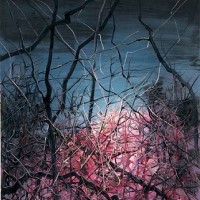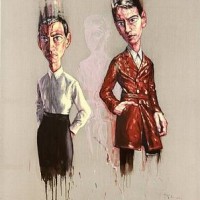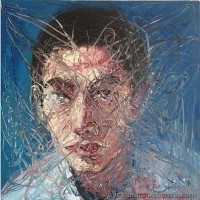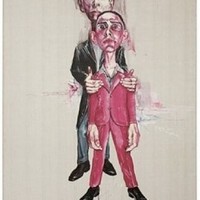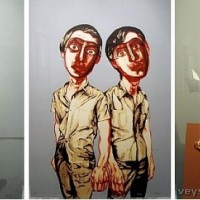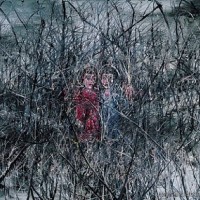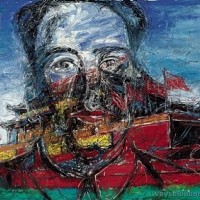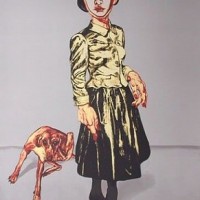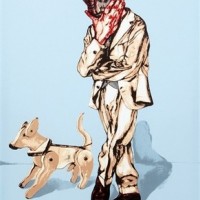- Home
- ABOUT US
- ABOUT VEYSEL BABA
- REDFOX ART HOUSE VIRTUAL TOUR
- MY LAST WILL TESTAMENT
- NOTES ON HUMANITY AND LIFE
- HUMAN BEING IS LIKE A PUZZLE WITH CONTRADICTIONS
- I HAVE A WISH ON BEHALF OF THE HUMANITY
- WE ARE VERY EXHAUSTED AS THE DOOMSDAY IS CLOSER
- NO ROAD IS LONG WITH GOOD COMPANY
- THE ROAD TO A FRIENDS HOUSE IS NEVER LONG
- MY DREAMS 1
- MY DREAMS 2
- GOLDEN WORDS ABOUT POLITICS
- GOLDEN WORDS ABOUT LOVE
- GOLDEN WORDS ABOUT LIFE
- GOLDEN WORDS ABOUT DEATH
- VEYSEL BABA ART WORKS
- SHOREDITCH PARK STORIES
- EXAMPLE LIVES
- ART GALLERY
- BOOK GALLERY
- MUSIC GALLERY
- MOVIE GALLERY
- Featured Article
- Home
- ART GALLERY
- Zeng Fanzhi
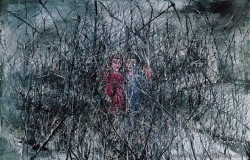
Zeng Fanzhi
Zeng Fanzhi (Chinese: 曾梵志; born 1964 in Wuhan, Hubei) is a contemporary Chinese artist based in Beijing. From the earliest stages of his career, Zeng Fanzhi's paintings have been marked by their emotional directness, the artist's intuitive psychological sense, and his carefully calibrated expressionistic technique. Moving to Beijing in the early 1990s, Zeng's art displayed an immediate shift, responding to his immersion in a more superficial environment, his seminal Mask series displaying the tensions between the artist's dominant existential concerns and an ironic treatment of the pomposity and posturing inherent to his new contemporary urban life. Throughout, Zeng's expressionistic techniques run counter to such techniques' conventional usage. That is, Zeng's representation of raw, exposed flesh or awkwardly oversized hands is not an attempt at pure emotional expression, but instead play against the superficially composed appearances of his subjects, an ironic treatment of emotional performance as a metaphor for a lost self, of stunted self-realization.
Early life
Zeng Fanzhi was born in 1964 in Wuhan, Hubei and lives and works in Beijing.[1] He grew up during the Cultural Revolution, after which he attended Hubei Academy of Fine Arts.[1] There, he was largely influenced by Expressionism. Zeng is one of the most popular artists of his era,[1] in addition to being one of Asia's most financially successful artists.[2] In May 2008, he set a world auction record when one of his contemporary Chinese art pieces "Mask Series 1996 No. 6" was sold for $9.6 million in Hong Kong.[1] Zeng has lived and worked in Beijing since 1993, and has been exhibited all over the globe in venues such as the Shanghai Art Museum, National Art Museum of China, Kunst Museum Bonn, Kunstmuseum Bern, Santa Monica Art Centre, Art Centre,[1] and Le Musée d'Art moderne de la Ville de Paris.[3]
Art school
Zeng was in art school from 1987 to 1991, and paid a particular interest in German expressionist painters.[4] During his third year of schooling, he began instead to learn more about the actual approaches that the expressionists would take to painting.[4] By the time his first show came to fruition, it was apparent that he had gained his very own style and the work gained him a large amount of respect in the Chinese art scene.[4]
Artistic progression
From the start, Zeng has been heavily influenced by his physical and emotional circumstances. Zeng's first mature series was his "Hospital Series", inspired by the scenes he witnessed in the local clinic near where he lived. At the same time, as an art student, Zeng studied German Expressionism, and the preponderance of social upheaval and intensely felt emotion, against a backdrop of social upheaval, had resonance in his own life. In his Hospital series, Zeng moved to a theme that included the use of hospital interiors, where he devoted much of the detail to the patients' moods and the power that certain brush stroking techniques could yield.[4] These paintings often hinted at a sadomasochistic relationship in the world with his pale colors and blood colored flesh of the patients.[4] In using these techniques, he shows a somewhat pessimistic view of the world.[4] His expressionist technique shined through in these works further with an extreme expression in the eyes of the characters.[4] Also, the hands of the patients are notably oversized and the joints are much larger as well.[4] The scenes he depicts seem to show patients caught up in seeming hysteria, and the deep red colors show anger of sorts.[4]
After 1994, Zeng's work shifted toward his Mask series in which his style takes a drastic shift that is considered the second period in his work.[4] Instead of the anger and brutal nature of the hospital series, the Mask series is more apathetic.[4] The scenes are painted from a distance, and have a mask of some sort as the center of focus.[4] The groups are often small or include a single person, and that seems to show that Zeng is touching on personal relationships and the fact that society is filled with false relationships.[4] By using a mask, even if a person is with a group, there is a sense of solitude for the person wearing the mask.[4] He also explores new techniques that include using a palette knife as a paintbrush.[4] This causes the characters to have an even more blurred edge to them, which essentially masks the painting as a whole.[4] The lighting on the paintings are not coming from an obvious source, and the characters seem to be separated from the world around them through an awkward placement in the background.[4] Through the different techniques, the characters seem much more calm than his earlier hospital series.[4] The figures' hands are in fists and also much more realistic and apparent than in the past, and this causes them to seem as though they are controlling an emotion instead of venting anger, etc.[4]
The art by Zeng after 1997 becomes much more stylish through the incorporation of new types of backgrounds like the sea.[4] He uses softer colors that are more blended into each other and this makes for a more comfortable viewing experience.[4] Rather than anger or a controlled emotion, these figures are more relaxed and their hands are sometimes in their pockets.[4] This seems to show that the artist's mood at the time is also more relaxed and has an understanding of life.[4] What was once angry and bold has become more calm through different brush strokes, but there is still a sort of anxiety that can be noted by the fact that the characters have larger-than-normal heads.[4] Rather than his expressionist beginnings, his work now seems to consist largely of symbolism.[4]
We n:2
We n:2 is both an abstract and a self-portrait of Zeng Fanzhi.[5] The fact that the face is so large and dominating causes the viewer to feel almost minuscule in its presence.[5] He uses squiggle lines that create a screen that describes the impossibility of truly knowing someone.[5] The marks that he makes over his face almost cause a "ghost image, echoing multiplicity and technological distortion."[5]
This Land Is So Rich in Beauty 2
Considering the expressionist style of Zeng's work, the viewer seems to feel violent tension.[6] His landscapes are some of his best work, and while painting them he uses two separate brushes.[6] In doing so, one brush demonstrates the purpose of what he is painting, and the other is "leaving traces of his subconscious through processes."[6] This causes his landscapes to not only have a real feel to them, but also an abstract sense of expression.[6]
Tiananmen
In an effort to describe the rocky past, Zeng places an abstract version of chairman Mao over the building in Tiananmen Square.[7] The bright reds and oranges show both an ironic sense of great courage over the top of an uncertain future.[7] The painting is given animation with a flurry of brush strokes that replace what would normally be depicted as stoic and straight-laced.[7] The fact that chairman Mao's portrait dominates the painting is possibly a symbol for his dominance over Chinese culture.[7]
Art market
In May 2008, Christie's Hong Kong pioneered the Asian Contemporary Art Evening sale. Zeng Fanzhi's Mask Series No.6 was sold for HK$75,367,500. Christie's Hong Kong set a world auction record for the artist in 2008.
In October 2013, Sotheby's Hong Kong at the Asian Contemporary 40th Anniversary Sale, Zeng Fanzhi's The Last Supper was sold for US$23.3 million, setting a new record for contemporary Asian artwork.
